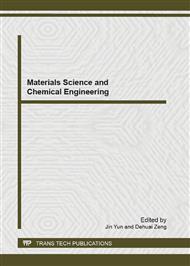[1]
B.J. Finlayson-Pitts, J. N. Pitts, Jr. "Chemistry of the Upper and Lower Atmosphere"Academic Press: San Diego, CA, 2000.
Google Scholar
[2]
L.J. Butler, E.J. Hintsa, S.F. Shane and Y.T. Lee, "The electronic state-selective photodissociation of CH2BrI at 248, 210, and 193 nm" J. Chem. Phys., vol. 86, no. 4, pp.2051-2074, 1987.
DOI: 10.1063/1.452155
Google Scholar
[3]
W.B. Tzeng, Y.R. Lee, S.M. Lin, "Photodissociation of CH2BrCl at 248 nm and 193 nm Investigated by Translational Spectroscopy," Chem. Phys. Lett., vol. 227, pp.467-471, 1994.
DOI: 10.1016/0009-2614(94)00837-x
Google Scholar
[4]
W.S. Mcgivern, R.-J. Li, P. Zou and S.W. North, "Photodissociation Dynamics of CH2BrCl Studied using Resonance Enhanced Multiphoton Ionization (REMPI) with Time-of-Flight Mass Spectrometry," J. Chem. Phys., vol. 111, no. 13, pp.5771-5779, 1999.
DOI: 10.1063/1.479874
Google Scholar
[5]
S.-H. Yin, H.-P. Liu, J.-Y. Zhang, et al, "Femtosecond Pump-Probe Mass Spectra on the Dissociative Photoionization of CF3I," Chem. Phys. Lett., vol. 372, pp.904-910, 2003.
DOI: 10.1016/s0009-2614(03)00555-4
Google Scholar
[6]
N.H. Damrauer, C. Dietl, G. Krampert, et al, "Control of Bond-selective Photochemistry in CH2BrCl using Adaptive Femtosecond Pulse Shaping," Eur. Phys. J. D., vol. 20, pp.71-76, 2002.
DOI: 10.1140/epjd/e2002-00101-8
Google Scholar
[7]
P. Marshall, G.N. Srinivas and M. Schwartz, "A Computational Study of Thermochemistry of Bromine- and Iodine-Containing Methanes and Methyl Radicals," J. Phys. Chem. A., vol. 109, no. 28, pp.6371-6379, 2005.
DOI: 10.1021/jp0518052
Google Scholar
[8]
Z.-J. Li, X. Shan, X.-F. Yang, et al, "Valence Electronic Structures of CH2BrCl and CF2BrCl: Binding Energy Spectra and Electron Momentum Distributions," J. Phys. Chem. A., vol. 112, no. 5, pp.942-949, 2008.
DOI: 10.1021/jp709645d
Google Scholar
[9]
R. Tamas and G. Leticia, "A Two-Dimensional Wavepacket Study of the Nonadiabatic Dynamics of CH2BrCl," J. Phys. Chem. A., vol. 112, no. 25, pp.5573-5581, 2008.
Google Scholar
[10]
Toshiyuki Takayanagi and Atsushi Yokoyama, "The Role of Nonadiabatic Coupling in Bond-Selective Dissociations: Two-Dimensional Model Calculations," Bull. Chem. Soc. Jpn., vol. 68, no. 8, p.2225, 1995.
DOI: 10.1246/bcsj.68.2225
Google Scholar
[11]
J.B Foresman and A. Frisch, Exploring Chemistry with Electronic Structure Methods, 2nd ed, Gaussian, PA: Pittsburgh, 2002.
Google Scholar
[12]
K.A. Peterson and T.H. Dunning, "Benchmark Calculations with Correlated Molecular Wave Functions. VII. Binding Energy and Structure of the HF Dimer," J. Chem. Phys., vol. 102, no. 5, pp.2032-2041, 1995.
DOI: 10.1063/1.468725
Google Scholar
[13]
M.J. Frisch, G.W. Trucks, H.B. Schlegel, et al, GAUSSIAN03, Gaussian, Inc., PA: Pittsburgh, 2003.
Google Scholar


